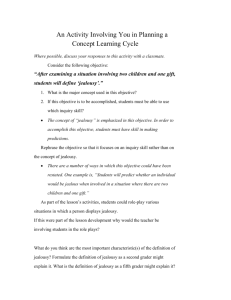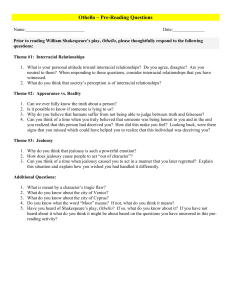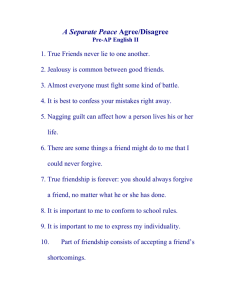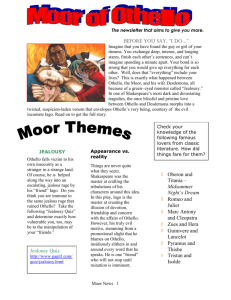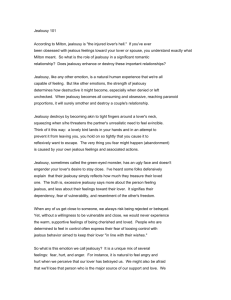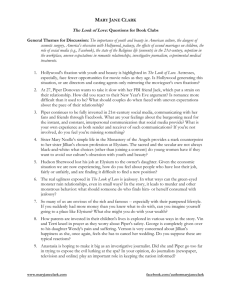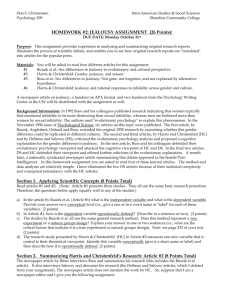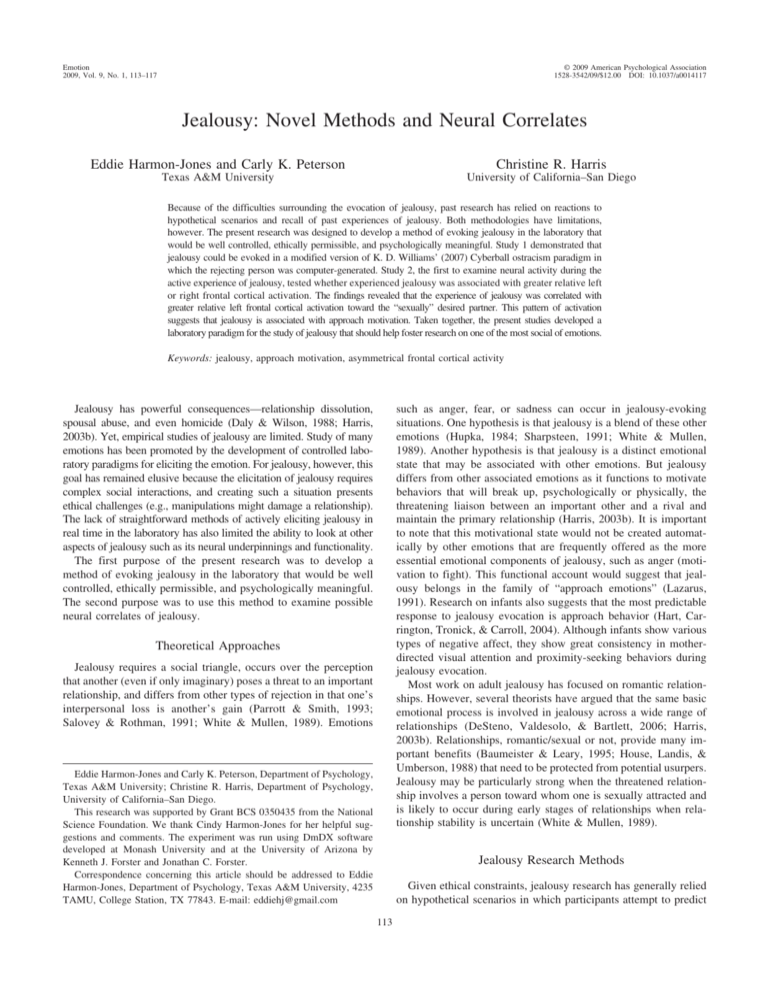
Emotion
2009, Vol. 9, No. 1, 113–117
© 2009 American Psychological Association
1528-3542/09/$12.00 DOI: 10.1037/a0014117
Jealousy: Novel Methods and Neural Correlates
Eddie Harmon-Jones and Carly K. Peterson
Christine R. Harris
Texas A&M University
University of California–San Diego
Because of the difficulties surrounding the evocation of jealousy, past research has relied on reactions to
hypothetical scenarios and recall of past experiences of jealousy. Both methodologies have limitations,
however. The present research was designed to develop a method of evoking jealousy in the laboratory that
would be well controlled, ethically permissible, and psychologically meaningful. Study 1 demonstrated that
jealousy could be evoked in a modified version of K. D. Williams’ (2007) Cyberball ostracism paradigm in
which the rejecting person was computer-generated. Study 2, the first to examine neural activity during the
active experience of jealousy, tested whether experienced jealousy was associated with greater relative left
or right frontal cortical activation. The findings revealed that the experience of jealousy was correlated with
greater relative left frontal cortical activation toward the “sexually” desired partner. This pattern of activation
suggests that jealousy is associated with approach motivation. Taken together, the present studies developed a
laboratory paradigm for the study of jealousy that should help foster research on one of the most social of emotions.
Keywords: jealousy, approach motivation, asymmetrical frontal cortical activity
such as anger, fear, or sadness can occur in jealousy-evoking
situations. One hypothesis is that jealousy is a blend of these other
emotions (Hupka, 1984; Sharpsteen, 1991; White & Mullen,
1989). Another hypothesis is that jealousy is a distinct emotional
state that may be associated with other emotions. But jealousy
differs from other associated emotions as it functions to motivate
behaviors that will break up, psychologically or physically, the
threatening liaison between an important other and a rival and
maintain the primary relationship (Harris, 2003b). It is important
to note that this motivational state would not be created automatically by other emotions that are frequently offered as the more
essential emotional components of jealousy, such as anger (motivation to fight). This functional account would suggest that jealousy belongs in the family of “approach emotions” (Lazarus,
1991). Research on infants also suggests that the most predictable
response to jealousy evocation is approach behavior (Hart, Carrington, Tronick, & Carroll, 2004). Although infants show various
types of negative affect, they show great consistency in motherdirected visual attention and proximity-seeking behaviors during
jealousy evocation.
Most work on adult jealousy has focused on romantic relationships. However, several theorists have argued that the same basic
emotional process is involved in jealousy across a wide range of
relationships (DeSteno, Valdesolo, & Bartlett, 2006; Harris,
2003b). Relationships, romantic/sexual or not, provide many important benefits (Baumeister & Leary, 1995; House, Landis, &
Umberson, 1988) that need to be protected from potential usurpers.
Jealousy may be particularly strong when the threatened relationship involves a person toward whom one is sexually attracted and
is likely to occur during early stages of relationships when relationship stability is uncertain (White & Mullen, 1989).
Jealousy has powerful consequences—relationship dissolution,
spousal abuse, and even homicide (Daly & Wilson, 1988; Harris,
2003b). Yet, empirical studies of jealousy are limited. Study of many
emotions has been promoted by the development of controlled laboratory paradigms for eliciting the emotion. For jealousy, however, this
goal has remained elusive because the elicitation of jealousy requires
complex social interactions, and creating such a situation presents
ethical challenges (e.g., manipulations might damage a relationship).
The lack of straightforward methods of actively eliciting jealousy in
real time in the laboratory has also limited the ability to look at other
aspects of jealousy such as its neural underpinnings and functionality.
The first purpose of the present research was to develop a
method of evoking jealousy in the laboratory that would be well
controlled, ethically permissible, and psychologically meaningful.
The second purpose was to use this method to examine possible
neural correlates of jealousy.
Theoretical Approaches
Jealousy requires a social triangle, occurs over the perception
that another (even if only imaginary) poses a threat to an important
relationship, and differs from other types of rejection in that one’s
interpersonal loss is another’s gain (Parrott & Smith, 1993;
Salovey & Rothman, 1991; White & Mullen, 1989). Emotions
Eddie Harmon-Jones and Carly K. Peterson, Department of Psychology,
Texas A&M University; Christine R. Harris, Department of Psychology,
University of California–San Diego.
This research was supported by Grant BCS 0350435 from the National
Science Foundation. We thank Cindy Harmon-Jones for her helpful suggestions and comments. The experiment was run using DmDX software
developed at Monash University and at the University of Arizona by
Kenneth J. Forster and Jonathan C. Forster.
Correspondence concerning this article should be addressed to Eddie
Harmon-Jones, Department of Psychology, Texas A&M University, 4235
TAMU, College Station, TX 77843. E-mail: eddiehj@gmail.com
Jealousy Research Methods
Given ethical constraints, jealousy research has generally relied
on hypothetical scenarios in which participants attempt to predict
113
BRIEF REPORTS
114
their reactions or on retrospective recall of jealous experiences.
Such approaches have limitations. Reactions to hypothetical scenarios that do little to engage the participant may be poor proxies
for emotional responding in real situations, as research suggests
that people are inaccurate in predicting feelings in a variety of
situations (Wilson & Gilbert, 2005). People are particularly poor at
predicting their reactions to hypothetical events involving jealousy
and infidelity. Such responses have little correspondence with
responses to real infidelity as measured through recall or behavior
(Harris, 2002, 2003a). Hypothetical measures may show poor
validity because they evoke complex inferential thinking rather
than immediate emotional reactions (e.g., DeSteno, Bartlett,
Braverman, & Salovey, 2002; DeSteno & Salovey, 1996; Harris &
Christenfeld, 1996). The second research method, retrospective
recall, has the virtue of being based on actual past emotional
experiences rather than participants’ ability to imagine people,
relationships, and events that do not exist. However, recall is
subject to limitations such as memory failure or bias.
Controlled experimental paradigms for evoking jealousy are
almost nonexistent in the adult literature. One notable exception is
work that examined coping reactions to a rival in established
romantic relationships via phone calls (Mathes, Adams, & Davies,
1985). Recently, DeSteno and colleagues (2006) elicited jealousy
in the lab through orchestrated social encounters in which a participant is rejected by a partner (a confederate) in favor of a third
person. This work provided direct evidence for the role of selfesteem threat in the elicitation of jealousy and further documented
the link between jealousy and interpersonal aggression.
Current Work
Jealousy is theorized to be intricately connected with rejection,
specifically rejection by the object of one’s desires in favor of
someone else. Our work builds on experimental methods to examine other types of reactions to social rejection (Eisenberger,
Lieberman, & Williams, 2003; Williams, Cheung, & Choi, 2000),
particularly a paradigm in which participants were either ostracized or included during Cyberball—a cyber analogue of a balltossing game— by two other players (Williams, 2007). This work
demonstrated that rejection threatens fundamental psychological
needs and produces negative feelings. Exclusion even by imaginary computer-generated players produces negative reactions
(Williams, 2007; Zadro, Williams, & Richardson, 2004). However, previous work with this paradigm has not manipulated or
measured jealousy.
In Study 1, we sought to create a “minimal” paradigm that would
be sufficient to evoke jealousy. Under the guise of making the
experience easier to imagine in real life, participants selected one of
the other two players from a set of female (or male) photos. Then, they
played a Cyberball game while photographs of the selected player and
another player of the same sex as the participant were displayed. After
being included for a few minutes, participants continued to be included or were ostracized by the same-sex or opposite-sex player they
had chosen earlier. Because jealousy results from threatened loss of a
relationship, we expected individuals to become jealous when rejected
by another person, and to feel particularly jealous when ostracized by
an opposite-sex individual.
The current work extends jealousy research by providing a
paradigm that actively elicits jealousy in real time in the laboratory
without potentially risking negative influences on the participant’s
actual relationships. It provides greater experimental control than
is possible with interpersonal interactions that use scripts and
confederates in a face-to-face interaction. Finally, it examines
whether jealousy can be evoked under minimal psychological
circumstances where the social rejection occurs via computer and
not by an actual person.
Study 1
Method
Participants were 80 male and 82 female introductory psychology students who received course credit for participation. After
informed consent, participants completed a questionnaire, indicating how they had felt during the past few weeks on a number of
emotion words including the word jealous (1 ⫽ very slightly or not
at all, 7 ⫽ extremely). They then viewed photos of eight potential
players and were given the opportunity to choose one player “to
make the experience easier to imagine in real life.” Half of the
participants selected one player from among only male photos,
whereas the other half selected one player from among only female
photos. The third (nonchosen) player in the Cyberball game was
always the same gender as the participant.
As in Zadro et al. (2004), participants were told that the study was
to “test the effects of practicing mental visualization on task performance.” Participants then played the Cyberball game by pressing the
left shift key to throw to the player on the left and the right shift key
to throw to the player on the right. All participants were included
during the first 2 min of the game. Then, half of the participants were
ostracized during the second half of the game (the ball was not thrown
to them). When the ostracism occurred, the chosen partner’s eyes,
which were previously fixated on the participant, moved so that they
now gazed at the other player. This was done to enhance the emotional impact of the ostracism (see Figure 1). Finally, participants
completed a questionnaire to assess emotions and other reactions they
had during the game (see Zadro et al., 2004).
Figure 1. a) Example of female player in possession of the ball while the
participant is being included; b) Example of female player possessing the
ball while the participant is being ostracized. Printed with permission of
Raymond Serra and Aimee Howarth.
BRIEF REPORTS
Results and Discussion
A 2 (same vs. opposite sex from participant) ⫻ 2 (ostracism vs.
inclusion) analysis of covariance (ANCOVA) was conducted, with
baseline jealousy serving as the covariate. It produced the predicted interaction, F(1, 154) ⫽ 5.24, p ⫽ .02, partial 2 ⫽ .03. As
shown in Figure 2, participants felt more jealous when ostracized
than when included, and they felt more jealous when ostracized by
an opposite-sex partner as compared to a same-sex partner, ps ⬍
.05. Additional analyses revealed that male and female participants
did not differ from each other in the jealousy they felt, ps ⬎ .10.
Replicating past research, ostracism, as compared to inclusion,
caused more anger and lower feelings of inclusion, belonging,
control, self-esteem, and meaningful existence, all Fs ⬎ 19.50. No
interactions with same versus opposite sex of target occurred, Fs ⬍
1.95. Thus, the effects of same/opposite sex and inclusion/
ostracism were specific to jealousy. Additional ANCOVAs controlling for the effects of these other outcome variables revealed
that the Same/Opposite Sex ⫻ Inclusion/Ostracism interaction on
jealousy remained significant, all Fs ⬎ 4.03, ps ⬍ .05, partial
2s ⬎ .03. Across conditions, zero-order correlations revealed that
the change in jealousy was correlated positively with anger (r ⫽
.41, p ⬍ .01) and negatively with feelings of inclusion, belonging,
control, and meaningful existence (all rs ⬍ ⫺.22, ps ⬍ .01).
Previous research and theory have suggested that situations that
evoke jealousy also threaten self-esteem and increase other negative affects (DeSteno et al., 2006; Hupka, 1984; Sharpsteen, 1991;
White & Mullen, 1989). However, the current experiment suggests
that the Same/Opposite Sex ⫻ Inclusion/Ostracism interaction
continued to predict jealousy even when controlling for these other
states.
As predicted, ostracism by a computer-generated opposite-sex
partner caused greater feelings of jealousy than ostracism by a
same-sex partner. Moreover, both types of ostracism caused more
115
jealousy than inclusion by any partner. That jealousy was evoked
in such a paradigm is important and suggests new insights into the
nature of jealousy. We would suggest that some attraction existed
in the opposite-sex conditions as individuals chose which
opposite-sex person with whom to work. However, we do not
believe that our results are relevant to the issue of sex differences
in response to sexual infidelity (which is debated; Harris, 2003b)
because there was no sexual infidelity. The ostracizing person
simply did not throw the cyberball to the participant. Such could
just as easily be interpreted as emotional infidelity. Thus, this
manipulation does not readily lend itself to being categorized by
either sexual versus emotional infidelity (nor do many acts for that
matter). However, what is important is that the situation did have
elements of some kind of attraction and people did report feeling
jealousy.
Study 2
In Study 2, we examined some of the neural circuitry involved
in jealousy. In particular, we were interested in assessing whether
the experience of jealousy was associated with greater relative left
or right frontal cortical activation. Much research has revealed that
the prefrontal cortex is asymmetrically involved in approach–
withdrawal motivation, with greater relative left frontal activation
being associated with approach motivation and greater relative
right frontal activation being associated with withdrawal motivation (see review by Coan & Allen, 2004). For instance, experiments revealed that both approach-motivated positive affects
(Davidson, Saron, Senulis, Ekman, & Friesen, 1990) and
approach-motivated anger cause greater relative left frontal cortical activity than appropriate control conditions (Harmon-Jones,
Lueck, Fearn, & Harmon-Jones, 2006). Other experiments revealed that withdrawal-oriented negative affects such as disgust
Figure 2. Self-reported jealousy as a function of inclusion or ostracism by same-sex or opposite-sex target
(Study 1).
116
BRIEF REPORTS
and sadness cause greater relative right frontal cortical activity
than appropriate control conditions (Jones & Fox, 1992).
These asymmetrical activations are more likely to be observed
using individual differences approaches when the situational manipulations are relatively weak. For instance, relative left frontal
activation was observed only to mild anger cues in individuals high
in trait anger (Harmon-Jones, 2007). Also, relative left frontal
activation was observed only to mildly positive approachmotivating stimuli (pictures of desserts) in individuals who had not
recently eaten and in individuals who find desserts particularly
likable (Gable & Harmon-Jones, 2008).
The association of the experience of jealousy with the basic
motivational impulse to approach or withdraw from the evoking
stimulus has, to our knowledge, yet to be examined empirically.
Lazarus (1991) proposed that jealousy activates angry impulses to
attack as well as action tendencies associated with yearning and
love, all of which are approach-oriented action tendencies. Thus,
we predicted that jealousy in a minimal paradigm would be associated with greater relative left frontal activation, particularly
among individuals who feel more jealous. This prediction is predicated on the idea that jealousy is associated with action tendencies
of approach.
Method
Methods were identical to Study 1 with the following exceptions. Because of our interest in examining the neural correlates of
the jealousy experience, EEG was recorded throughout the game
and only the condition that evoked “sexual” jealousy was run (i.e.,
the participant was rejected by the female partner he had chosen in
favor of another male). Ten right-handed introductory psychology
male students participated.
EEG was recorded with 59 tin electrodes mounted in a stretchlycra electrode cap (Electro-Cap, Eaton, OH). The ground electrode was on the midline between the frontal pole and the frontal
site. The reference electrode was placed on the left ear, and data
were also acquired from an electrode on the right ear, so that an
offline, averaged ears’ reference could be computed. Vertical and
horizontal eye movements (EOG) were also recorded to facilitate
artifact correction of the EEG. All electrode impedances were
under 5,000 ohms, and homologous sites were within 1,000 ohms
of each other. EEG and EOG were amplified with Neuroscan
Synamps (El Paso, TX), bandpass filtered (0.05 to 100 Hz) and
digitized at 500 Hz (an analog 60-Hz notch filter was enabled).
Signals were visually scored and portions of the data that
contained artifacts were removed. Then, a regression-based eye
movement correction was applied, after which the data were again
visually inspected. All epochs 1.024 s in duration were extracted
through a Hamming window. A fast Fourier transform was used to
calculate the power spectra, which were averaged across epochs of
each player’s possession of the ball during each Cyberball game.
Because recent research has revealed motivationally relevant
asymmetrical frontal cortical activations to be more strongly associated with power in the high alpha band (10.5–13 Hz; Pizzagalli, Sherwood, Henriques, & Davidson, 2005), our analyses
focused on this. An average frontal asymmetry index (AF3/4, F3/4,
F7/8, F5/6, FC5/6) was created, based on past research with fewer
electrodes that focused on F3/4 and F7/8. A comparison asymmetry index over the parietal region was also created (P3/4, P5/6,
P7/8, CP3/4, PO5/6). This index was included as in past research
to test whether hemispheric effects are specific to the frontal
regions. Because alpha power is inversely related to cortical activity, higher scores indicate greater left hemisphere activity. To
examine the asymmetrical activations in response to jealousy
alone, we created all asymmetry variables by subtracting the
activity observed during the inclusion portion of the game from the
activity observed during the exclusion portion of the game. Selfreported emotional responses were processed similarly, by subtracting baseline emotion reports from emotion reports collected at
the end of the game.
Results and Discussion
As expected, jealousy was associated with greater relative
left frontal activation when the female player held the ball and
was rejecting the participant (female rejection), r ⫽ .71, p ⫽ .02.
Also, relative left frontal activation during female rejection was
associated with greater anger, r ⫽ .72, p ⫽ .02, and lower inclusion, r ⫽ ⫺.67, p ⫽ .03. This asymmetry index was not significantly associated with other responses to ostracism. Additional
regressions were conducted to examine whether entry of these two
significant variables would eliminate the relationship between
relative left frontal activation and jealousy. Neither variable eliminated the left frontal–jealousy relationship, partial rs ⬎ .57, ps ⬍
.05 (one-tailed, which is justified given the directionality of the
prediction).
In addition, relative left frontal activation during male rejection
was not significantly associated with any variables; it was, however, marginally and inversely associated with anxiety, r ⫽ ⫺.60,
p ⫽ .07, suggesting that greater relative right frontal activation
during male rejection was associated with feelings of anxiety. In
this study, the male participants chose the female player but did not
choose the male player. It is likely that this act of choosing the
female partner created more of a budding relationship than simply
being assigned a partner. This greater investment would cause the
participants to feel more jealousy over the rejection and to be more
approach motivated toward the female player than the male player.
In contrast to the frontal asymmetry, the parietal asymmetry
index during female rejection was inversely (and nonsignificantly)
correlated with jealousy, r ⫽ ⫺.48, p ⫽ .16. It was also nonsignificantly correlated with all other responses except feelings of
control, r ⫽ .64, p ⫽ .05. Parietal asymmetry during male rejection
was not associated with any responses except belonging, r ⫽ .82,
p ⫽ .004. These two correlations suggest that greater relative right
parietal activation was associated with lower feelings of control
during female rejection and lower feelings of belonging during
male rejection. Although research on parietal asymmetries is not as
established as the frontal asymmetry literature, some work has
found relatively greater right parietal activity to be associated with
depression (see review by Bruder, 2003). The current findings are
consistent with this research on depression.
Zero-order correlations among variables revealed that the
change in jealousy was not significantly correlated with any other
variables. However, jealousy did correlate in expected directions
with some of the variables: It was positively correlated with
anger, r ⫽ .50, p ⫽ .14, negatively correlated with feelings of
inclusion, r ⫽ ⫺.44, p ⫽ .20, and negatively correlated with
self-esteem, r ⫽ ⫺.57, p ⫽ .09. That jealousy is correlated with
BRIEF REPORTS
other types of negative affect and self-esteem is not surprising,
as discussed previously. However, the current work suggests
that jealousy is associated with greater relative left frontal
activity even when controlling for these other states.
General Discussion
The present research was designed to develop a controlled and
psychologically meaningful way of evoking jealousy in the laboratory free of ethical concerns. The results of the two studies
suggest that this goal was accomplished. In addition, Study 2 was
designed to examine whether jealousy was associated with neural
circuitry involved in approach or withdrawal motivation. Based on
past research suggesting that relative left frontal cortical activity is
associated with approach motivation and on past theories suggesting that jealousy would be associated with approach motivation,
we predicted and found that jealousy is associated with relative left
frontal activity. These results are consistent with theories that
propose that the primary motivational state in jealousy, at least
initially, is one of approach (Lazarus, 1991). More specifically,
these approach inclinations may manifest in behaviors aimed at
breaking up the threatening liaison or reestablishing the primary
relationship (Harris, 2003b). These neurophysiological results also
suggest that the self-reported responses obtained in Study 1 were
not simply due to demand characteristics.
A final purpose of the present studies was to develop a wellcontrolled, minimal laboratory paradigm to which additional variables could readily be added in further research examining how
various factors affect the intensity of jealousy. We believe that our
paradigm accomplished such and hope that it will be used in
further research on interpersonal relationships, emotions, and the
neural circuits involved in such psychological processes.
References
Baumeister, R. F., & Leary, M. R. (1995). The need to belong: Desire for
interpersonal attachments as a fundamental human motivation. Psychological Bulletin, 117, 497–529.
Bruder, G. E., (2003). Frontal and parietotemporal asymmetries in depressive disorders: Behavioral, electrophysiologic, and neuroimaging findings. In K. Hugdahl & R. J. Davidson (Eds.), The asymmetrical brain
(pp. 719 –742). Cambridge, MA: MIT Press.
Coan, J. A., & Allen, J. J. B. (2004). Frontal EEG asymmetry as a
moderator and mediator of emotion. Biological Psychology, 67, 7– 49.
Daly, M., & Wilson, M. (1988). Homicide. Hawthorne, NY: Aldine de
Gruyer.
Davidson, R. J., Saron, C. D., Senulis, J. A., Ekman, P., & Friesen, W. V.
(1990). Approach withdrawal and cerebral asymmetry—Emotional expression and brain physiology. 1. Journal of Personality and Social
Psychology, 58, 330 –341.
DeSteno, D., Bartlett, M., Braverman, J., & Salovey, P. (2002). Sex
differences in jealousy: Evolutionary mechanism or artifact of measurement? Journal of Personality and Social Psychology, 83, 1103–1116.
DeSteno, D. A., & Salovey, P. (1996). Evolutionary origins of sex differences in jealousy? Questioning the “fitness” of the model. Psychological
Science, 7, 367–372.
DeSteno, D., Valdesolo, P., & Bartlett, M. Y. (2006). Jealousy and the
threatened self: Getting to the heart of the green-eyed monster. Journal
of Personality and Social Psychology, 91, 626 – 641.
Eisenberger, N. I., Lieberman, M. D., & Williams, K. D. (2003, October
117
10). Does rejection hurt? An fMRI study of social exclusion. Science,
302, 290 –292.
Gable, P. A., & Harmon-Jones, E. (2008). Relative left frontal activation to
appetitive stimuli: Considering the role of individual differences. Psychophysiology, 45, 275–278.
Harmon-Jones, E. (2007). Trait anger predicts relative left frontal cortical
activation to anger-inducing stimuli. International Journal of Psychophysiology, 66, 154 –160.
Harmon-Jones, E., Lueck, L., Fearn, M., & Harmon-Jones, C. (2006). The
effect of personal relevance and approach-related action expectation on
relative left frontal cortical activity. Psychological Science, 17, 434 – 440.
Harris, C. R. (2002). Sexual and romantic jealousy in heterosexual and
homosexual adults. Psychological Science, 13, 7–12.
Harris, C. R. (2003a). Factors associated with jealousy over real and
imagined infidelity: An examination of the social– cognitive and evolutionary psychology perspectives. Psychology of Women Quarterly, 27,
319 –329.
Harris, C. (2003b). A review of sex differences in sexual jealousy, including
self-report data, psychophysiological responses, interpersonal violence and
morbid jealousy. Personality and Social Psychology Review, 7, 102–128.
Harris, C. R., & Christenfeld, N. (1996). Gender, jealousy, and reason.
Psychological Science, 7, 364 –366.
Hart, S., Carrington, H., Tronick, E. Z., & Carroll, S. (2004). When infants
lose exclusive maternal attention: Is it jealousy? Infancy, 6, 57–78.
House, J. S., Landis, K. R., & Umberson, D. (1988, July 29). Social
relationships and health. Science, 241, 540 –545.
Hupka, R. B. (1984). Jealousy: Compound emotion or label for a particular
situation? Motivation and Emotion, 8, 141–155.
Jones, N. A., & Fox, N. A. (1992). Electroencephalogram asymmetry
during emotionally evocative films and its relation to positive and
negative affectivity. Brain and Cognition, 20, 280 –299.
Lazarus, R. S. (1991). Emotion and adaptation. New York: Oxford University Press.
Mathes, E. W., Adams, H. E., & Davies, R. M. (1985). Jealousy: Loss of
relationship rewards, loss of self-esteem, depression, anxiety, and anger.
Journal of Personality and Social Psychology, 42, 1552–1561.
Parrott, W. G., & Smith, R. H. (1993). Distinguishing the experiences of envy
and jealousy. Journal of Personality and Social Psychology, 64, 906 –920.
Pizzagalli, D. A., Sherwood, R. J., Henriques, J. B., & Davidson, R. J.
(2005). Frontal brain asymmetry and reward responsiveness—A sourcelocalization study. Psychological Science, 16, 805– 813.
Salovey, P., & Rothman, A. (1991). Envy and jealousy: Self and society.
In P. Salovey (Ed.), The psychology of jealousy and envy (pp. 271–286).
New York: Guilford Press.
Sharpsteen, D. J. (1991). The organization of jealousy knowledge: Romantic jealousy as a blended emotion. In P. Salovey (Ed.), The psychology
of jealousy and envy (pp. 31–51). New York: Guilford Press.
White, G., & Mullen, P. E. (1989). Jealousy: Theory, research, and clinical
strategies. New York: Guilford Press.
Williams, K. D. (2007). Ostracism. Annual Review of Psychology, 58,
425– 452.
Williams, K. D., Cheung, C. K. T., & Choi, W. (2000). Cyberostracism:
Effects of being ignored over the Internet. Journal of Personality and
Social Psychology, 79, 748 –762.
Wilson, T. D., & Gilbert, D. T. (2005). Affective forecasting: Knowing what
to want. Current Directions in Psychological Science, 14, 131–134.
Zadro, L., Williams, K. D., & Richardson, R. (2004). How low can you go?
Ostracism by a computer is sufficient to lower self-reported levels of
belonging, control, self-esteem, and meaningful existence. Journal of
Experimental Social Psychology, 40, 560 –567.
Received April 28, 2008
Revision received August 21, 2008
Accepted September 8, 2008 䡲

